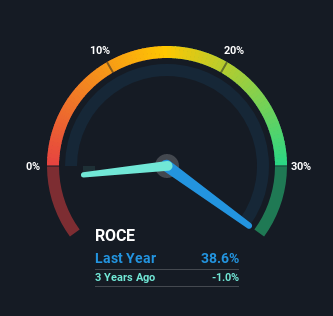- Poland
- /
- Retail Distributors
- /
- WSE:SFD
Investors Shouldn't Overlook SFD's (WSE:SFD) Impressive Returns On Capital
To find a multi-bagger stock, what are the underlying trends we should look for in a business? Firstly, we'll want to see a proven return on capital employed (ROCE) that is increasing, and secondly, an expanding base of capital employed. Basically this means that a company has profitable initiatives that it can continue to reinvest in, which is a trait of a compounding machine. Speaking of which, we noticed some great changes in SFD's (WSE:SFD) returns on capital, so let's have a look.
What is Return On Capital Employed (ROCE)?
Just to clarify if you're unsure, ROCE is a metric for evaluating how much pre-tax income (in percentage terms) a company earns on the capital invested in its business. The formula for this calculation on SFD is:
Return on Capital Employed = Earnings Before Interest and Tax (EBIT) ÷ (Total Assets - Current Liabilities)
0.39 = zł16m ÷ (zł69m - zł27m) (Based on the trailing twelve months to September 2021).
Therefore, SFD has an ROCE of 39%. In absolute terms that's a great return and it's even better than the Retail Distributors industry average of 16%.
Check out our latest analysis for SFD

While the past is not representative of the future, it can be helpful to know how a company has performed historically, which is why we have this chart above. If you're interested in investigating SFD's past further, check out this free graph of past earnings, revenue and cash flow.
What Does the ROCE Trend For SFD Tell Us?
Investors would be pleased with what's happening at SFD. Over the last five years, returns on capital employed have risen substantially to 39%. Basically the business is earning more per dollar of capital invested and in addition to that, 139% more capital is being employed now too. So we're very much inspired by what we're seeing at SFD thanks to its ability to profitably reinvest capital.
One more thing to note, SFD has decreased current liabilities to 39% of total assets over this period, which effectively reduces the amount of funding from suppliers or short-term creditors. So this improvement in ROCE has come from the business' underlying economics, which is great to see.
In Conclusion...
In summary, it's great to see that SFD can compound returns by consistently reinvesting capital at increasing rates of return, because these are some of the key ingredients of those highly sought after multi-baggers. Since the stock has returned a staggering 574% to shareholders over the last five years, it looks like investors are recognizing these changes. In light of that, we think it's worth looking further into this stock because if SFD can keep these trends up, it could have a bright future ahead.
One final note, you should learn about the 4 warning signs we've spotted with SFD (including 1 which can't be ignored) .
If you want to search for more stocks that have been earning high returns, check out this free list of stocks with solid balance sheets that are also earning high returns on equity.
New: Manage All Your Stock Portfolios in One Place
We've created the ultimate portfolio companion for stock investors, and it's free.
• Connect an unlimited number of Portfolios and see your total in one currency
• Be alerted to new Warning Signs or Risks via email or mobile
• Track the Fair Value of your stocks
Have feedback on this article? Concerned about the content? Get in touch with us directly. Alternatively, email editorial-team (at) simplywallst.com.
This article by Simply Wall St is general in nature. We provide commentary based on historical data and analyst forecasts only using an unbiased methodology and our articles are not intended to be financial advice. It does not constitute a recommendation to buy or sell any stock, and does not take account of your objectives, or your financial situation. We aim to bring you long-term focused analysis driven by fundamental data. Note that our analysis may not factor in the latest price-sensitive company announcements or qualitative material. Simply Wall St has no position in any stocks mentioned.
About WSE:SFD
SFD
Engages in the wholesale and retail of nutrients, dietary supplements, and sports accessories in Poland.
Adequate balance sheet with slight risk.
Market Insights
Community Narratives




